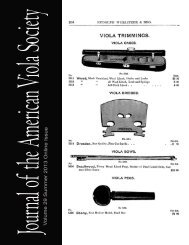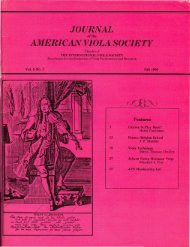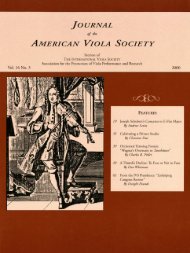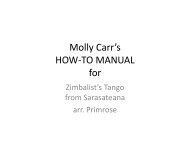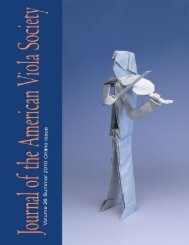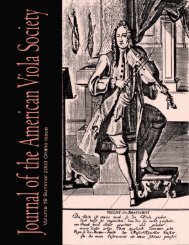Journal of the American Viola Society Volume 10 No. 2, 1994
Journal of the American Viola Society Volume 10 No. 2, 1994
Journal of the American Viola Society Volume 10 No. 2, 1994
Create successful ePaper yourself
Turn your PDF publications into a flip-book with our unique Google optimized e-Paper software.
Is AN ORCHESTRAL CAREER YOUR GOAL?<br />
Every year, many gifted and hopeful<br />
young musicians compete for positions in our<br />
symphony orchestras. Unfortunately, as many<br />
as one hundred candidates may audition for<br />
just one opening in a string section.<br />
Only a small number <strong>of</strong> <strong>the</strong>se young<br />
musicians are chosen for final auditions. The<br />
best <strong>of</strong> this group stand out for <strong>the</strong>ir excellence.<br />
My years <strong>of</strong> experience at Chicago<br />
Symphony Orchestra (CSO) auditions have<br />
taught me <strong>the</strong> abilities and qualities necessary<br />
for a successful candidate.<br />
These finalists not only play <strong>the</strong>ir concerti<br />
in an outstanding manner, but <strong>the</strong>ir<br />
orchestral excerpts are also very polished and<br />
at <strong>the</strong> same level <strong>of</strong>excellence.<br />
The first decision is <strong>the</strong> choice <strong>of</strong> <strong>the</strong><br />
concerto. The Bartok is <strong>the</strong> most popular<br />
choice. The Schwanendreher is played less frequently,<br />
as is <strong>the</strong> Walton. I have also used <strong>the</strong><br />
Tibor Serly, but this is now out <strong>of</strong> print.<br />
Excellent second choices are <strong>the</strong> ''Arpeggione''<br />
and movements from <strong>the</strong> Bach Cello Suites.<br />
In judging <strong>the</strong> suitability <strong>of</strong> o<strong>the</strong>r<br />
works, one should consider whe<strong>the</strong>r <strong>the</strong> work<br />
starts <strong>of</strong>f impressively, since candidates seldom<br />
have <strong>the</strong> time to play more than three<br />
pages. The concerto should show <strong>the</strong> virtuosity,<br />
musicianship, flair, and expressiveness <strong>of</strong><br />
<strong>the</strong> player. Candidates must feel that <strong>the</strong> work<br />
has musical substance and that <strong>the</strong>y can play<br />
it in a convincing manner.<br />
Orchestra managements now send lists<br />
to <strong>the</strong> applicants <strong>of</strong> works from <strong>the</strong> standard<br />
literature to be prepared. These should be<br />
performed at <strong>the</strong> highest level possible. At<br />
CSO auditions, <strong>the</strong> orchestra parts are considered<br />
as important as, if not more important<br />
than, <strong>the</strong> concerto. At <strong>the</strong> preliminary<br />
audition, which is held behind a screen,<br />
. <strong>the</strong> audition committee evaluates <strong>the</strong> experience<br />
<strong>of</strong> <strong>the</strong> candidate and determines whe<strong>the</strong>r<br />
he or she has a strong sense <strong>of</strong> rhythm, secure<br />
intonation, and fine tone quality. Although<br />
individual personality is desirable, a candidate<br />
whose playing is exaggerated and overly<br />
rhapsodic would not be considered likely to<br />
blend well in a section. The violist's sense <strong>of</strong><br />
by William Schoen<br />
style in <strong>the</strong> various compositions should be<br />
appropriate for <strong>the</strong> composers and <strong>the</strong> periods<br />
<strong>of</strong> time in which <strong>the</strong> works were written. The<br />
tempi must be within <strong>the</strong> range generally performed<br />
by orchestras in concert and on<br />
recordings.<br />
If <strong>the</strong> player has not had several years <strong>of</strong><br />
experience and is somewhat unfamiliar with<br />
many <strong>of</strong> <strong>the</strong> standard works, I recommend<br />
that he or she seek instruction from a highly<br />
qualified orchestra violist. If <strong>the</strong> works<br />
required for <strong>the</strong> audition involve complete<br />
movements, which is unlikely, <strong>the</strong> whole<br />
movement must be prepared. Typical excerpts<br />
range in length from a line or two to a page <strong>of</strong><br />
musIC.<br />
Importance <strong>of</strong> Rhythm<br />
Rhythm must not be erratic, and rests<br />
should be scrupulously observed; <strong>the</strong> rests are<br />
as important as <strong>the</strong> notes. There should be no<br />
rushing or dragging. <strong>No</strong>tes should be held for<br />
<strong>the</strong>ir full value. Rhythm is <strong>the</strong> prime requisite<br />
for <strong>the</strong> first-class orchestra player.<br />
Bow strokes must be appropriate for <strong>the</strong><br />
style <strong>of</strong> <strong>the</strong> work. Tone quality will be judged<br />
not only for its beauty but also for how it will<br />
blend in a section. Is <strong>the</strong> sound harsh in fortissimo?<br />
Does it have core and body in piano?<br />
Does <strong>the</strong> player play mezz<strong>of</strong>orte throughout<br />
<strong>the</strong> excerpt, with little regard for dynamics? Is<br />
<strong>the</strong> vibrato alive in s<strong>of</strong>t playing? How secure<br />
is <strong>the</strong> intonation? Does <strong>the</strong> violist show artistic<br />
maturity?<br />
The applicant must be flexible, for he or<br />
she may be asked to playa phrase in a higher<br />
position, or somewhat faster or slower. More<br />
attention to dynamics may be pointed out. A<br />
candidate should be able to produce a resonant,<br />
warm, or thick sound, but should also<br />
be able to playa phrase with a leaner or more<br />
transparent sound as required.<br />
It is important to display a fine sustained<br />
legato. Also, a well-trained bow arm<br />
should produce an excellent detache and various<br />
spiccati and staccati. Avoid technical<br />
problems such as uncoordinated passages,<br />
poor string crossings, and uneven finger or<br />
7



